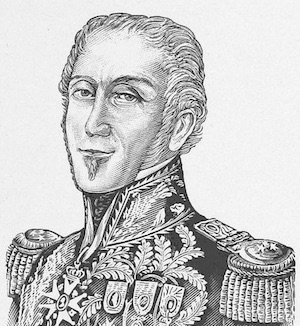General François Martin Valentin Simmer

Born: August 7, 1776
Place of Birth: Rodemack, Moselle, France
Died: July 30, 1847
Place of Death: Clermont-Ferrand, France
Arc de Triomphe: SIMMER on the west pillar
Volunteering to join the army during the Revolution, François Martin Valentin Simmer joined the 4th Battalion of the Moselle in 1791. In September of 1792 he was commissioned as a sous-lieutenant in the 7th Cavalry and he served in the Army of the North. In 1793 Simmer took part in relieving the Siege of Maestricht and he was wounded by a shot that broke his right arm. The next year he was promoted to lieutenant and he then fought at the Battle of Tourcoing where he was again wounded. In 1795 Simmer joined the Army of the Coasts of the Cherbourg and he was wounded by a shot to the left shoulder. The next year Simmer joined the Army of the Rhine and then in 1797 he was promoted to capitaine. In 1798 he served with the Army of Switzerland and then the Army of the North, and in 1799 he joined the Army of Holland.
After the years of peace that followed, Simmer was employed in the camp of Brest in 1804. In 1805 he joined the staff of Marshal Augereau's VII Corps and he served with VII Corps for the next few years. In February of 1807 as the remnants of VII Corps were reorganized after the Battle of Eylau, Simmer was promoted to chef d'escadrons and attached to the general staff of the Grande Armée. That June he served at Heilsberg where he was wounded by two shots of grapeshot and he went on to serve at the Battle of Friedland. The next year Simmer served in Spain and then Portugal, taking part in the siege of Evora in Portugal.
In 1809 Simmer was recalled to serve in the Army of Germany. During the Danube campaign that year he was wounded in the knee by a ball at Aspern-Essling and he went on to serve at the Battle of Wagram . The next month he was named a Baron of the Empire and he became the chief of staff of the 1st Division of II Corps. Simmer returned to Spain to serve in 1810 and then in 1811 he was named chief of staff of the 3rd military division at Metz. That year he went on to command the mobile column of the 19th military division and he was then named chief of staff of Compans' 5th Division of Davout's I Corps. Simmer remained in this position as chief of staff to Compans' division for the campaign against Russia of 1812. He took part in the attack on redoubt of the Schwardino on September 5, 1812 where he was wounded by two shots. During the retreat Simmer was promoted to général de brigade in October and then in November he served at Krasnoe where he had three horses killed underneath him. Still fighting, Simmer took part in the Battle of the Berezina where he was again wounded. Afterwards he took charge of the 2nd Division of I Corps.
Simmer took part in the campaigns of 1813 in Germany, commanding the 1st Brigade of Charpentier's 36th Infantry Division in Marshal Macdonald's XI Corps. That May he was named a Commander of the Legion of Honor and then in August he was wounded by a ball at the combat of Goldberg. For the defense of France of 1814, Simmer continued to serve under Marshal Macdonald. After Napoleon's abdication in April of 1814, the restored Bourbons named Simmer a Knight of Saint Louis and gave him command of the département of Puy-de-Dôme.
When Napoleon returned from exile to resume power in 1815 for the Hundred Days, Simmer rallied to him, bringing the 72nd of the Line to Napoleon's side. Napoleon promoted Simmer to général de division in April and then gave him command of the 19th Infantry Division of Mouton's VI Corps. Simmer served during the campaign in Belgium that June and led his men at the Battle of Waterloo. After Napoleon's second abdication, the once again restored Bourbons demoted Simmer back to the rank of général de brigade and exiled him to Le Mans.
Bibliography
Updated March 2017
© Nathan D. Jensen